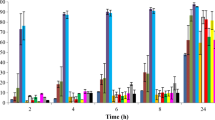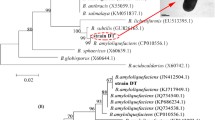Abstract
The biotechnological potential of Microcystis aeruginosa brings requirements for efficient cultivation and harvesting of biomass. Flocculation of M. aeruginosa at alkaline pH induced by calcium or magnesium precipitates was studied under model conditions, in culture medium with/without cellular organic matter (COM). The effect of independent variables (Ca2+, Mg2+, PO43−, and pH) on the zeta potential and turbidity of cells and inorganic precipitates was quantified by response surface methodology. The experimentally obtained flocculation efficiencies (FEs) were compared with predictions of physicochemical interaction (DLVO) models. The results presented here delimited the concentration ranges of Ca2+, Mg2+, PO43−, and pH, resulting in FE > 85%. The DLVO prediction model suggested that for high FE, positively charged precipitates and sufficient precipitate turbidity were required. At pH 10, alkaline flocculation was more advantageous using magnesium precipitates, since it required less phosphate. High FE with COM was achieved at pH 12 when precipitate formation was induced at a low phosphate concentration by the addition of magnesium hydroxide.


Similar content being viewed by others
References
Brady PV, Pohl PI, Hewson JC (2014) A coordination chemistry model of algal autoflocculation. Algal Res 5:226–230
Branyikova I, Filipenska M, Urbanova K, Ruzicka MC, Pivokonsky M, Branyik T (2018) Physicochemical approach to alkaline flocculation of Chlorella vulgaris induced by calcium phosphate precipitates. Colloids Surf B 166:54–60
Folkman Y, Wachs AM (1973) Removal of algae from stabilization pond effluents by lime treatment. Water Res 7:419–435
Geada P, Gkelis S, Teixeira J, Vasconcelos V, Vicente A, Fernandes B (2017a) Cyanobacterial toxins as a high added-value product. In: Muñoz R, Gonzalez C (eds) Microalgae-based biofuels and bioproducts. Woodhead Publishing, Cambridge, pp 405–432
Geada P, Pereira RN, Vasconcelos V, Vicente AA, Fernandes BD (2017b) Assessment of synergistic interactions between environmental factors on Microcystis aeruginosa growth and microcystin production. Algal Res 27:235–243
Gerardo ML, Van Den Hende S, Vervaeren H, Coward T, Skill SC (2015) Harvesting of microalgae within a biorefinery approach: a review of the developments and case studies from pilot-plants. Algal Res 11:248–262
González-Fernández C, Ballesteros M (2013) Microalgae autoflocculation: an alternative to high-energy consuming harvesting methods. J Appl Phycol 25:991–999
Hermansson M (1999) The DLVO theory in microbial adhesion. Colloids Surfaces B 14:105–119
Ito T, Okabe K, Mori M (2018) Growth reduction of Microcystis aeruginosa by clay ball elution solution. Appl Clay Sci 162:223–239
Khan MI, Lee MG, Seo HJ, Shin JH, Shin TS, Yoon YH, Kim MY, Choi JI, Kim JD (2016) Enhancing the feasibility of Microcystis aeruginosa as a feedstock for bioethanol production under the influence of various factors. Biomed Res Int 2016:1–9
Khan MI, Lee MG, Shin JH, Kim JD (2017) Pretreatment optimization of the biomass of Microcystis aeruginosa for efficient bioethanol production. AMB Express 7:1–9
Kolska Z, Reznickova A, Svorcik I (2012) Surface characterization of polymer foils. E-polymers 083:1–13
Lawton LA, Edwards C (2008) Conventional laboratory methods for cyanotoxins. In: Hudnell HK (ed) Cyanobacterial Harmful Algal Blooms: State of the Science and Research Needs. Springer, New York, pp 513–537
Leentvar J, Rebhun ME (1982) Effect of magnesium and calcium precipitation on coagulation-flocculation with lime. Water Res 16:655–662
Lin Z, Xu Y, Zhen Z, Fud Y, Liu Y, Li W, Luo C, Ding A, Zhang D (2015) Application and reactivation of magnetic nanoparticles in Microcystis aeruginosa harvesting. Bioresour Technol 190:82–88
Lürling M, Noymac NP, Magalhães L, Miranda M, Mucci M, van Oosterhout F, Huszar VLM, Marinho MM (2017) Critical assessment of chitosan as coagulant to remove cyanobacteria. Harmful Algae 66:1–12
Merel S, Walker D, Chicana R, Snyder S, Baures E, Thomas O (2013) State of knowledge and concerns on cyanobacterial blooms and cyanotoxins. Environ Int 59:303–327
Molina Grima E, Belarbi EH, Acién Fernández FG, Robles Medina A, Chisti Y (2003) Recovery of microalgal biomass and metabolites: process options and economics. Biotechnol Adv 20:491–515
Naceradska J, Pivokonsky M, Pivokonska L, Baresova M, Henderson RK, Zamyadi A, Janda V (2017) The impact of pre-oxidation with potassium permanganate on cyanobacterial organic matter removal by coagulation. Water Res 114:42–49
Nguyen TDP, Frappart M, Jaouen P, Pruvost J, Bourseau P (2014) Harvesting Chlorella vulgaris by natural increase in pH: effect of medium composition. Environ Technol 35:1378–1378
Niedermeyer THJ, Daily A, Swiatecka-Hagenbruch M, Moscow JA (2014) Selectivity and potency of microcystin congeners against OATP1B1 and OATP1B3 expressing cancer cells. PLoS One 9:e91476
Paerl HW, Hall NS, Calandrino ES (2011) Controlling harmful cyanobacterial blooms in a world experiencing anthropogenic and climatic-induced change. Sci Total Environ 409:1739–1745
Pivokonsky M, Safarikova J, Baresova M, Pivokonska L, Kopecka I (2014) A comparison of the character of algal extracellular versus cellular organic matter produced by cyanobacterium, diatom and green alga. Water Res 51:37–46
Prochazkova G, Podolova N, Safarik I, Zachleder V, Branyik T (2013) Physicochemical approach to freshwater microalgae harvesting with magnetic particles. Colloids Surf B 112:213–218
Safarikova J, Baresova M, Pivokonsky M, Kopecka I (2013) Influence of peptides and proteins produced by cyanobacterium Microcystis aeruginosa on the coagulation of turbid waters. Sep Purif Technol 118:49–57
Shi W, Tan W, Wang L, Pan G (2016) Removal of Microcystis aeruginosa using cationic starch modified soils. Water Res 97:19–25
Sukenik A, Shelef G (1984) Algal autoflocculation - verification and proposed mechanism. Biotechnol Bioeng 26:142–147
Tappan E, Chamberlin AR (2008) Activation of protein phosphatase 1 by a small molecule designed to bind to the enzyme’s regulatory site. Chem Biol 15:167–174
van Oss CJ (1995) Hydrophobicity of biosurfaces — origin, quantitative determination and interaction energies. Colloids Surf B 5:91–110
Vandamme D, Foubert I, Fraeye I, Meesschaert B, Muylaert K (2012) Flocculation of Chlorella vulgaris induced by high pH: role of magnesium and calcium and practical implications. Bioresour Technol 105:114–119
Vandamme D, Foubert I, Muylaert K (2013) Flocculation as a low-cost method for harvesting microalgae for bulk biomass production. Trends Biotechnol 31:233–239
Wang L, Liang W, Yu J, Liang Z, Ruan L, Zhang Y (2013) Flocculation of Microcystis aeruginosa using modified larch tannin. Environ. Sci Technol 47:771–5777
Yap RKL, Whittaker M, Diao M, Stuetz RM, Jefferson B, Bulmus V, Peirson WL, Nguyen AV, Henderson RK (2014) Hydrophobically-associating cationic polymers as micro-bubble surface modifiers in dissolved air flotation for cyanobacteria cell separation. Water Res 61:253–262
Funding
This research was supported by the Grant Agency of the Czech Republic (project 18-05007S).
Author information
Authors and Affiliations
Corresponding author
Ethics declarations
Conflict of interest
The authors declare that they have no conflict of interest.
Additional information
Publisher’s note
Springer Nature remains neutral with regard to jurisdictional claims in published maps and institutional affiliations.
Rights and permissions
About this article
Cite this article
Potočár, T., Pereira, J.A.V., Brányiková, I. et al. Alkaline flocculation of Microcystis aeruginosa induced by calcium and magnesium precipitates. J Appl Phycol 32, 329–337 (2020). https://doi.org/10.1007/s10811-019-01941-3
Received:
Revised:
Accepted:
Published:
Issue Date:
DOI: https://doi.org/10.1007/s10811-019-01941-3




